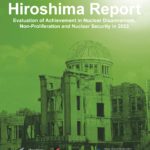III Summary
As outlined above, in the case of Hiroshima, the war reconstruction plans played a role in modernizing the city. Before suffering damages in the war, Hiroshima still had many features of a feudal castle town, but the historical vestiges and atmosphere of the old city were eliminated, and the city lost many of its distinct characteristics during the war reconstruction. Within a relatively short period of time, many major cities and war-damaged cities in Japan were rebuilt in this way. This certainly was a major endeavor.
At the same time, it can be said that the planning of the reconstruction of Hiroshima, as an A-bombed city, started by assuming the mission of modernizing the city and of conveying a message as a city that experienced an atomic bombing. At the time, however, because the plan had to be made and implemented within a very limited time, without being able to examine it fully, the first reconstruction plan did not go through enough scrutiny. In addition, the operations were brought to a standstill by financial constraints, and the first reconstruction plan eventually had to be revised.
In order to carry out the reconstruction plans, public land needed to be reserved through the process of land readjustment. That is to say, outside the readjustment area, there was no way to bring about the implementation of reconstruction plans. The readjustment process was indeed a difficult task, costing both time and money. The foundation for reconstruction remained unconsolidated, but the demand for housing construction, and the citizens’ dissatisfaction continued to grow stronger.
The most distinctive feature of the Japanese reconstruction process was that administrative bodies were responsible for preparing land while the construction of buildings on the land was left up to the landowners (or those with rights to use the land). What types of buildings would be built, and in what manner, was also left to the initiative of the people. Within this lied the basic nature of the reconstruction process in Japan.
(Norioki Ishimaru)
Notes and References
Ministry of Construction (Ed.). Sensai Fukkoshi: Dai Ikkan, Dai Nana Kan (Record of War Damage Reconstruction, Vol. l. and Vol. 7). Toshi Keikaku Kyokai, 1959. Total in 10 volumes.
First Demobilization Ministry (Ed.). Reprint of the original documents archived at the National Diet Library. Nihon Toshi Sensai Chizu (Maps of War Damage in Japanese Cities). Hara Shobo, 1983.
Ishida, Yorifusa. Nihon Kindai Toshi Keikaku no Hyakunen (100 Years of Modern Urban Planning in Japan). Jichitai Kenkyusha, 1987.
City of Hiroshima (Ed.). Hiroshima Shinshi: Toshi Bunka Hen (History of Postwar Hiroshima: Urban Culture). City of Hiroshima, 1983.
Inoue, Makoto. Shodo kara no Saisei, Sensai Fukko wa Ikani Nashieta ka (Recovery from the Scorched Earth: How the War-damage Reconstruction was Accomplished). Shinchosha, 2012.
Division of Planning and Coordination, City Planning Bureau, City of Hiroshima. Town Planning in Hiroshima, Hiroshima no Toshi Keikaku. City of Hiroshima. (in Japanese)







